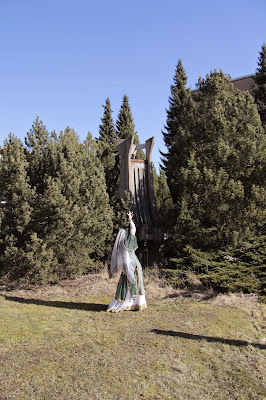This is a rather long post. Please feel encouraged to scroll down....
„PERSIAN
MINIATURE vs. GDR“
Beauty
as a reflection of the divine, the search for the light of Paradise
and the perpetual oscillation between the joy of the here and now as
well as the longing for dissolution in the infinite are
characteristic of the poetic impetus of Persian art.
In
order to underline this costumes and poses of Persian book
illustration ("miniatures") were put into the surreal
environments of industrial wasteland and GDR architecture.
The
incongrousness between the model and the surroundings creates
universal aesthetics beyond the alledged borders between Orient and
Occident. The dancer tests and eventually transcends cultural,
political and religious boundaries in the intuitive physical
experience of dance.
From
the 16 principles of urbanism, passed by the governement of the
German Democratic Republic on July 27, 1950:
"Cities
do no develop and exist 'per se'. Cities are predominantly build by
the industry and for the industry."
The
dancer, in contrast to the architecture, is not limited by space and
time, but dissolves and re-creates it in the movement.
Architecture
is history in itself, while the dancer is its thrown-into-existance
equivalent. The myth of dance exists in its nature beyond history.
Each conscious movement dwelling from emotion and artistic activity
leads finally to a collision of history and myth, where art comes to
existence and creativity and creation coincide.
"The growth of the city needs to be subordinated to the principle of
utility and has to respect certain boundaries."
The
city posseses space and spirit, and dance is spirit and space.
The
city has a topography and a building which remains solidly in one
place. It needs history and political change to wander around. The
buildings, once firmly anchored in the GDR, have been transported by
the stream of history, have changed their place in time and exist now
in a different country.
The
dancer, on the other side, takes her cultural and personal biography
and unfolds it like a garden into the free areas and spaces, as if
the Other did not exist.
"It is impossible to transform the city into a garden."
The
materialist essence of Marxism understands culture as created and not
as something which has developed. The creation of culture which
denies nature and time has transformed into a garden of delights and
mystical reveries. Like dance by itself grass breaks through the
concrete and conquers Time and Truth. In this process the building is
torn down and rebuilt by a dancer.










No comments:
Post a Comment